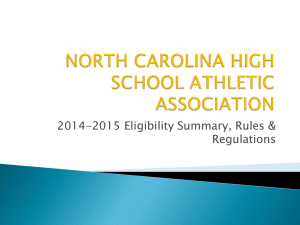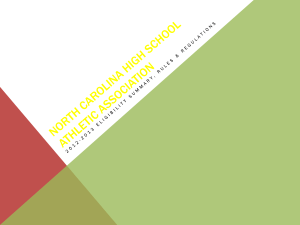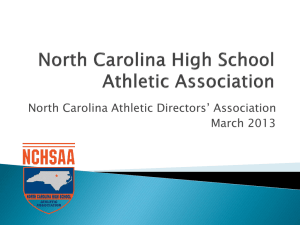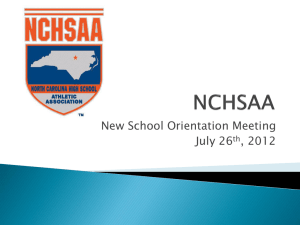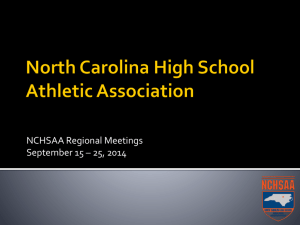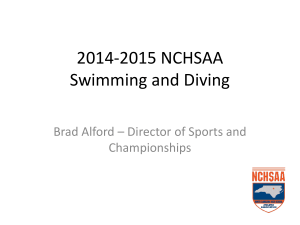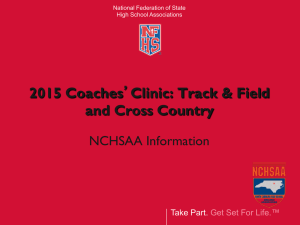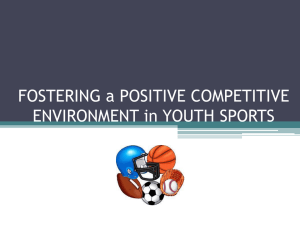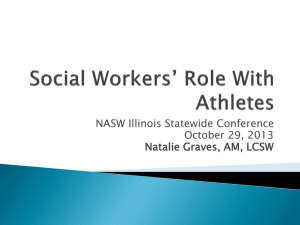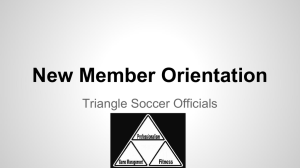nchsaa eligibility - North Carolina High School Athletic Association
advertisement
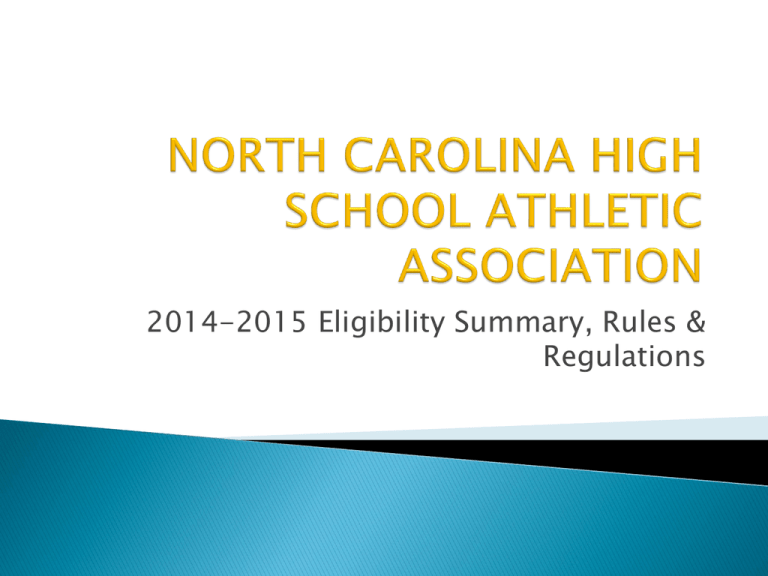
2014-2015 Eligibility Summary, Rules & Regulations HONOR YOURSELF HONOR YOUR TEAM HONOR YOUR COMMUNITY MAKE GOOD SPORTSMANSHIP A HABIT! Student may not participate if he/she becomes 19 years of age on or before August 31, 2014. Attendance requirements are set by the LEA and the 85% rule is no longer an NCHSAA requirement. Excused and unexcused absences are the determination of the LEA. Attendance is regulated by local LEA policy in terms of length of day required to be counted in attendance. Local attendance policy may be more stringent in terms of counting/earning credit for courses. Must pass a minimum load of course work the previous semester to be eligible at any time during the semester. Any student, including seniors, must also pass the minimum load even if they need fewer courses for graduation. All students must also meet local promotion standards, set by the L.E.A. and/or local school. Courses must be approved for credit, (i.e., audited courses would not count). Minimum load is defined as five (5) courses in the traditional school schedule. Minimum load is defined as three (3) courses on the “block” schedule. This applies to all student athletes, including seniors. If the school is on an A/B form of “block” scheduling, a student must pass six (6) of eight (8) courses during what would traditionally be defined as a semester. No work previously passed by a student may be submitted as part of a minimum load. A detailed example of the NCHSAA Academic Requirements, inclusive of HYBRID formats, can be found in the NCHSAA Handbook. Local units may be more restrictive, but not less restrictive, in regards to the academic requirements of the NCHSAA. Summer school work used to make up part of the minimum load must be applied to the most recent semester. Credit for summer school work is the determination of the local unit. A student not eligible at the beginning of the semester is not eligible at any time during the semester. Exception: a student who receives an incomplete or is awaiting a final grade due to EOC re-testing or any other state mandated testing, which causes him/her to fail to meet minimum scholastic requirements is ineligible until the course is satisfactorily completed. Eligibility is restored immediately. Student must be a regularly enrolled member of the school’s student body. Student must participate at the school to which he/she is assigned by the local board of education. School assignment is based on the residence of the parent or legal custodian (court ordered custody, not guardian) within the administrative unit. Student must live with the parents or legal custodian. A “legal custodian” is a person or agency awarded legal, court-ordered custody of a child. A student may not have two residences for eligibility purposes. In order for a change of residence to be bona fide at least the following facts must exist: The original residence must be abandoned as a residence; that is sold, rented or disposed of as a residence and must not be used as residence by any member of the family. The entire family must make the change and take with them the household goods and furniture appropriate to the circumstances. The change must be made with intent that the move is permanent. A student transferring from a member school to another member school within the same local education agency (LEA) must sit out 365 days for athletic participation. The LEA may create criteria for immediate athletic eligibility for transfers within the LEA. A student transferring from a member school in one LEA to another member school in another LEA (without a bona fide change of residence) must sit out 365 days for athletic participation. Exceptions for immediate athletic eligibility for transfers from one LEA to a different LEA will be heard by a special NCHSAA Transfer Committee. A student is eligible at any school upon initial entry into the ninth grade. After initial entry into the ninth grade, transfer and boundary criteria shall apply as follows: 1. Student shall live in the county where non-traditional school is located, or student will live within a 25-mile radius of the nontraditional school as measured by NCHSAA designated computer program. 2. Student is a member of a parochial church and submits authorized pastor verification form. No student may participate at a second school in the same sport season except in the event of a bona fide change of residence of the parent(s) or legal custodian. Change of schools must be contemporaneous with change of residence. A student is eligible at their assigned school if he/she attended school within that administrative unit the previous two (2) semesters, provided it meets LEA policy. Falsification of information in terms of eligibility will result in the student athlete(s) being declared ineligible for a period of 365 days from the point of notification to the NCHSAA. Student athlete will be prohibited from involvement in all athletic-related activity for the 180-day school year and any schoolsponsored activity(s) during the summer. Student must receive a medical examination once every 365 days by a duly licensed physician, nurse practitioner, or physicians assistant. Students absent from athletic practice for five (5) or more days due to illness or injury shall receive a medical release by a physician licensed to practice medicine before re-admittance to practice or contests. No student may be eligible to participate at the high school level for a period lasting longer than eight (8) consecutive semesters, beginning with the student’s first entry into ninth grade or an over-aged seventh or eight grade student’s participation on a high school team, whichever occurs first. No student may participate at the high school level for more than four (4) seasons in a sport (one season per year, i.e., A student could not play fall women’s soccer in one state and then play NCHSAA women’s soccer in the spring). A student must not be convicted of a felony in this or any other state, or be adjudicated as a delinquent for an offense that would be a felony if committed by an adult in this or any other state. A student may not play, practice or be on the roster if ineligible. This does not apply to summer workouts, but the student should be enrolled in your school…students must have a valid physical to be involved in summer workouts. Managers, statisticians, etc. do not have to meet NCHSAA eligibility standards. There shall be no Sunday practice in any sport. This includes the assembling of athletic squads (full teams or selected individuals) for purposes of viewing films, chalk talks, or other materials pertaining to the coaching of the team. A student may not dress for a game or scrimmage when he/she is not eligible to participate in the game. If serving an “ejection”, student may be in the bench area but may not be in uniform. If ejected, coach may not be on the premises during the contest and is not allowed to communicate with the coaches/team during the contest. To maintain amateur status, a student must not accept money or awards having utilitarian value (golf balls, clubs, tennis rackets, etc.) for participation in athletics. A student may accept an award (gift certificate/food coupon), each sport season, that does not exceed a value of $20.00. A student must not have signed a professional contract or played on a junior college /community college team. Each coach must sign off on the eligibility summary form that is signed by the principal and/or athletics director. Master Eligibility sheets are to be shared with each member school of your conference for each sport program. A mandatory parent/guardian meeting must be held to have the parent sign the parental permission form to acknowledge eligibility and sportsmanship policies/expectations have been reviewed. All non-faculty (non-teaching certified personnel) and all newly hired coaches (new to your LEA) must complete the NFHS “FUNDAMENTALS OF COACHING” certification prior to the first date of competition. This is for head coaches and assistant coaches. $500 fine for non-compliance. Course is an online offering through the National Federation (NFHS). To access and complete the course, go to nfhslearn.com . Cost of course is $35 and is a one-time completion requirement to be nationally certified. NCHSAA Board of Directors has mandated 100% of coaching staff(s) complete the NFHS “FUNDAMENTALS OF COACHING” course by August 1, 2015. $500 per-game fine for noncompliance. Head Coaches must attend an NCHSAA State Rules Clinic (either the NCCA Coaches Clinic in Greensboro or a regional State Rules Clinic conducted by the NCHSAA) prior to coaching in the first contest of the season. $400 fine if coaches do not attend. $500 fine per game for non-compliance. UNPAID FINES – Schools that have unpaid fines to the NCHSAA are not eligible to compete in the playoffs for that sport (i.e. baseball fine would be specific to baseball playoffs) unless the fine is paid two (2) days prior to the playoff reporting date for that sport. Any fine not paid at the end of the fiscal year (June 30) will carry over to the following school year making all teams at said school ineligible for playoffs until the fine is paid in full. Schools must pay their catastrophic insurance fees by October 1. Non-payment of fees by the deadline makes all teams at that school ineligible for NCHSAA Playoffs. Schools must pay their membership dues by November 1. Non-payment of fees by the deadline makes all teams at that school ineligible for NCHSAA Playoffs beginning with winter sports. Tobacco Products, Alcoholic Beverages and Controlled Substances at Game Site: “Participants, coaches, and other team representatives and game officials, including chain crew, official scorers and timers, should not use any tobacco product, alcoholic beverage or controlled substance at a game site; violation of the policy will be ejection from the contest.” Any head coach who has a student-athlete ejected for fighting, must take the NFHS “Teaching & Modeling Behavior” course before returning to coaching. Cost of the program is $20.00. Fax copy of certificate to Mark Dreibelbis @919/240-7396. FAILURE TO DO SO WILL RESULT IN FORFEITURE AND A $500.00 FINE. This is in addition to the EJECTION POLICY criteria sanctions as stated in the NCHSAA Handbook. Any coach who is ejected from a contest must take the NFHS “Teaching & Modeling Behavior” course ($20 fee) before returning to coaching in addition to serving the game sanctions for the ejection. Any student who is disqualified or ejected from a contest must take the NFHS “Sportsmanship” course (we no longer utilize the STAR Sportsmanship program) before returning to play. There is no fee for this course. Fax a copy of the NFHS SPORTSMANSHIP CERTIFICATE to Mark Dreibelbis @ 919/2407396. FLAGRANT CONTACT added as a provision to the ejection policy. Flagrant contact includes, but is not limited to combative acts such as: Maliciously running over the catcher/fielder without attempt to avoid contact Excessive contact out-of-bounds or away from playing action that is unwarranted and extreme in nature Tackling/taking down a player dangerously in a malicious manner Illegally hitting or cross-checking an opponent in an excessive manner with the Lacrosse stick (crosse) Flagrant Contact carries same penalty as all other NCHSAA Ejection Policy criteria – 1 game in football and 2 games in all other sports. When the combative act causes an opponent to retaliate, it is a fight and carries a double penalty. Un-sanctioned Sports/Activities Schools may sponsor teams in sports not sanctioned by the NCHSAA (e.g. gymnastics, weightlifting, women’s field hockey, men’s volleyball). Even though such sports are not sanctioned by the NCHSAA, member schools should work, wherever possible, to adhere to the ideals and guidelines established by the NCHSAA for their member schools in sports which they do sanction. The need to promote sportsmanship, to protect instructional time, or the physiological and emotional needs of maturing teens should not disappear simply because it is not a sport sanctioned by the NCHSAA. An online coach education course – “Concussion in Sports – What You Need to Know “ is now available from the National Federation of State High School Association (NFHS) at www.nfhslearn.com. This course is required (or more comprehensive concussion program) of all coaches prior to the start of their sports season! It is a free course. $500 fine per-game for non-compliance. The course provides a guide to understanding, recognizing, and properly managing concussion in high school sports. The course is FREE, but you must register at www.nfhslearn.com. The Centers for Disease Control (CDC) has endorsed the course and has provided many useful resources. A concussion is a traumatic injury to the brain and presents a wide variety of signs and symptoms ◦ ◦ ◦ ◦ ◦ ◦ ◦ ◦ ◦ ◦ ◦ Headache Confusion Amnesia (not remembering events before or after the injury) Vision changes Loss of consciousness Dizziness Irritability/emotional changes (inappropriate or atypical crying, laughing, etc) Nausea/vomiting Fatigue/feeling sluggish/slow/’foggy’ Having “bell rung’ Excessive fatigue/drowsiness ANY sign/symptom after a blow to the head is a concussion until proven otherwise A high school athlete should NEVER return to play on the day they suffer a concussion ◦ Returning an athlete to play before complete resolution of symptoms can lead to recurrent concussion, prolonged post-concussion symptoms, OR even ‘Second Impact Syndrome’ (which is often fatal) An athlete with suspected concussion cannot return to play until he/she is cleared by a licensed medical physician ◦ Managing concussions is difficult even for welltrained and experienced medical providers. Coaches, you do not want this responsibility (or liability). THIS IS NOW A STATE LAW! Take home point: At the end of the day, it’s not an athlete’s knee, ankle, or elbow… it’s his or her brain and you cannot get this one wrong. “WHEN IN DOUBT, SIT THEM OUT.” Cervical spine injuries are typically caused by contact with a forward flexed neck ‘spearing’ position Any numbness/tingling in BOTH arms is suspicious for a cervical spine injury a ‘stinger’ never causes burning in both arms Take Home Point: Any suspected cervical spine injury should be immobilized and evaluated by medical personnel Sudden cardiac death occurs in young athletes for a variety of reasons: Most are due to genetic abnormalities of heart rhythms or heart anatomy Drugs can trigger cardiac arrest (cocaine, stimulants, anabolic steroids, and ephedrine are common culprits) Heat stroke can lead to cardiac arrest Viral illnesses can cause ‘myocarditis’ (infection of the heart muscle) which can cause sudden cardiac arrest Sickle cell trait makes athletes more likely to have sudden cardiac arrest (more common in AfricanAmericans) There are red flags which can tip us off to undiagnosed heart problems Chest pain with exertion Passing out/fainting from exertion – this is not normal or due to being ‘out of shape’ Family history of a sudden cardiac death or unexplained death before age 50 Take home point: Any athlete who passes out or has chest pain with exertion needs a medical evaluation Asthma attacks remain a leading cause of death among young people Be aware of common asthma triggers: Respiratory infections Both extreme heat/humidity and cold/dry Pollen & other allergens Take home point: Know who your asthmatic athletes are & make sure they have accessible inhalers Death from heat illness is preventable Hydration is only one part of the solution Know who is at increased risk Obese, out of shape athletes Athletes with fever or recent stomach or respiratory infections Athletes with sickle cell trait Athletes with history of prior heat illness Athletes on illicit drugs, ADD meds, or supplements w/ stimulants Prevention is key Be aware of heat index (see handbook) ◦ General Rule for high risk 70 to 80 F with high humidity (> 70%) 80 to 90 F with moderate humidity 90 F with low humidity (< 30%) Practice at cooler times when feasible (mornings, evenings) Allow athletes/teams to acclimate and become accustomed to heat over time Allow regular breaks for cooling and hydration Monitor body weight pre/post practice Recognize early and initiate cooling immediately ◦ confusion, collapse, nausea/vomiting Skin infections are common in contact sports Most skin infections are relatively minor and self-limited Resistant staph infections (MRSA) have become quite common and can be severe Skin infections are spread by skin-to-skin contact, sharing pads/equipment/work-out gear, dirty equipment Any boil or abscess needs medical evaluation Take home point: the vast majority of skin infections can be prevented by good hygiene Shower right after every practice & game Do not share equipment, pads, work-out clothes, towels, etc Wash hands frequently with soap/water or antibacterial towels/gels Wash equipment, mats, clothes, towels, etc regularly 1. Can you play sports at one school while enrolled and attending another school? 2. Do students have to have up-to-date physicals to participate in summer workouts? 3. Can a student participate in 2 sports in the same season (i.e. football and soccer)? 4. Are home-schoolers eligible to participate in athletics at a NCHSAA member school? 5. Can open gym and skill development be held on the same day? 6. What are the eight ejectionable criteria? 7. If I am a coach at a NCHSAA member school, and also coach a select soccer, AAU basketball, fall baseball team, etc, are there any restrictions with working with my high school team members outside the high school season? 8. What is the maximum number of days a student can be absent from school and still be eligible to participate in athletics? 9. What is the minimum number of courses a student must pass at your school to be eligible to participate in athletics? 10. What is the minimum number of courses a student must take at your school to be eligible to participate in athletics? 11. Are certified athletic trainers required to attend practices and games? If so, which sports? How many? 12. What is the age cut-off date (turning 19 years of age) for participation in athletics in North Carolina? 13. Can you participate in the same sport for two different schools during the same season? If so, how? 14. What is the maximum monetary value of an award, an athlete can receive and retain their amateur status? 15. Are 8th-graders allowed to participate on your high school team? 16. What is the NCHSAA minimum GPA? 17. If a senior only needs 3 classes his senior year to graduate and takes 2 during the fall semester, is he/she eligible to participate in athletics during the spring semester? 18. How many days of mandatory summer practice does an athlete have to participate to be eligible for the upcoming season? 19. At which school would a student be eligible, if the parents are separated and they live part-time with each? Answers will be sent to Athletic Directors for discussion with all coaches
